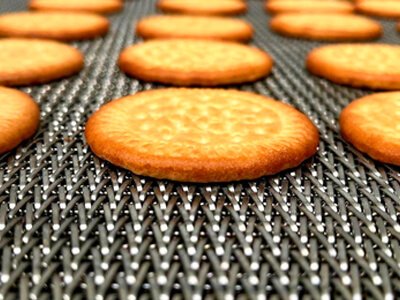Compound Balanced Weave Belts
HOME / PRODUCTS / Metal Conveyor Belts / Compound Balanced Weave Belts
Compound Balanced Weave Wire Mesh Conveyor Belt for Baking Bands, Heat Treat Industry and Furnace Curtains
Compound Balanced Weave Conveyor Belt, also named Cordweave Conveyor Belt, V-shaped Conveyor Belt. When this type of wire mesh belt is used for baking cookies, it is called CB5 baking band. Cordweave Conveyor Belts are a type of woven wire conveyor belt characterized by a distinctive construction consisting of alternating left-hand and right-hand spirals connected by straight cross-rod connectors. This configuration results in a tight mesh with close nesting of spirals, making the belt ideal for conveying very small parts.
Compound balance weave belts are often used in the Heat Treat Industry for fasteners or powders as well as baking bands in the Food Industry for tortillas, cookies, and crackers.
Specification
| Material | Stainless steel, carbon steel, and galvanized steels, high temperature alloys |
| Coil wire diameter | Round wire: 0.70 – 2.80 mm Flat wire: 1.20 x 0.70 – 2.00 x 1.0 mm |
| Cross wire diameter | 0.9 mm to 3.5 mm |
| Coil wire pitch | 2.8 mm to 12.5 mm |
| Cross wire pitch | 4.0 mm to 18 mm |
| Number of transverse wires per pitch | 2 to 5, and other as your need |
| Working temperature | up to 1250 °C |
Belt Types
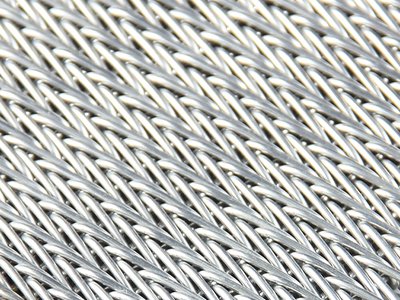

Standard Cordweave Belts
The standard cordweave belts consists of alternating left and right hand coils with each coil interconnecting with the next by means of a number of cross wires through each coil. The introduction of added cross wires through each coil allows for the close meshing of adjacent coils in both the width and length.The transverse wires are secured through welding, side plates, or by weaving them into bent sides. In this format both coil and cross wires are of round section. As a result, cordweave belts boasts high density and excellent heat retention properties.
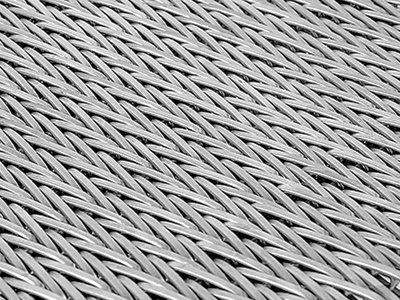

Cordweave Belts with Flat Wire Coil
Mesh specifications can be customized to incorporate coil wires that are manufactured using flattened wire. These alternative styles are particularly advantageous for increasing surface area when handling products with small base areas. When determining the coil wire, it is crucial to verify the cross-sectional dimensions to ensure compatibility with specific application requirements.
Edge Availability
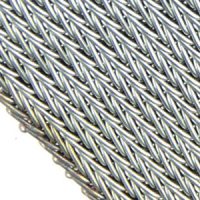

Compound Balanced Weave Belts with Welded Edge
The standard available type of edge finish for this application is welding, facilitated by the close meshing of both the crimp and cross wire.
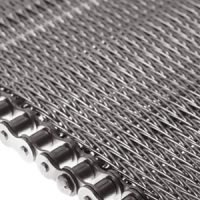

Compound Balanced Weave Belts with Chain Edge
This belt utilize the fundamental mesh structure described earlier but are uniquely equipped with chain edges for secure drive and tracking. In this configuration, the edge chain serves as the driving medium, pulling the mesh through the circuit.
Side Guard Availability
To enhance conveying performance and prevent products from falling to the ground, the compound weave conveyor belt is equipped with two types of baffles designed to address this issue.
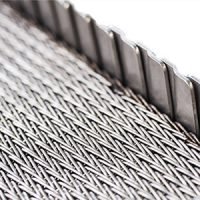

Compound Balanced Weave Belts with Metal Sheet Side Guard
Metal baffles can be added onto compound balanced weave conveyor belt.
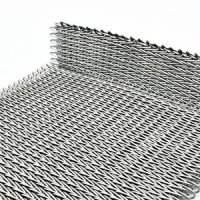

Compound Balanced Weave Belts with Folded Side Guard
Compound balanced weave conveyor belt can be folded directly to form a baffle.
Common Specifications of Compound Balanced Weave Belts
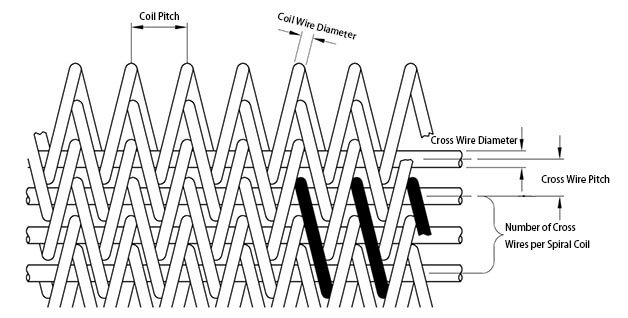

| Specification Coding | Coil Pitch (mm) | Cross Wire Pitch (mm) | Cross Wire Dia (mm) | Coil Wire Dia. (mm) | Number of Cross Wires per Coil |
| CB3-5.08-3.05-1.22-1.22 | 5.08 | 3.05 | 1.22 | 1.22 | 3 |
| CB4-11.7-6.5-3.0-2.6 | 11.7 | 6.5 | 3 | 2.6 | 4 |
| CB4-10.5-5.7-2.6-2.3 | 10.5 | 5.7 | 2.6 | 2.3 | 4 |
| CB4-9.0-5.0-2.3-2.0 | 9 | 5 | 2.3 | 2 | 4 |
| CB4-7.2-4.0-1.8-1.6 | 7.2 | 4 | 1.8 | 1.6 | 4 |
| CB4-6.5-3.8-1.8-1.4 | 6.5 | 3.8 | 1.8 | 1.4 | 4 |
| CB4-5.5-2.8-1.4-1.2 | 5.5 | 2.8 | 1.4 | 1.2 | 4 |
| CB4-4.5-2.3-1.2-1.0 | 4.5 | 2.3 | 1.2 | 1 | 4 |
| CB4-3.7-2.1-1.2-0.8 | 3.7 | 2.1 | 1.2 | 0.8 | 4 |
| CB5-8.71-3.39-1.63-1.3*1.3 | 8.71 | 3.39 | 1.63 | 1.6 x 1.3 | 5 |
| NOTE: 1. If flat wire, please give us cross section. 2. Custom specification is available if you can’t find the suitable size. | |||||
Material Availability
| Material | Maximum Operating Temperature °C |
| Carbon Steel | 550 |
| Galvanised Mild Steel | 400 |
| Chrome Molybdenum | 700 |
| 304 Stainless Steel | 750 |
| 316 Stainless Steel | 800 |
| 316L Stainless Steel | 800 |
| 310 Stainless Steel | 1100 |
| 314 Stainless Steel | 1150 |
| 35/19 Nickel Chrome | 1150 |
| 80/20 Nickel Chrome | 1150 |
| Inconel 600 | 1150 |
| Inconel 601 | 1200 |
| If you have other material requirements, please contact us. | |
Compound balance weave belts offer several advantages, making them suitable for various industrial applications. Here are some key advantages of compound balance weave belts:
- Small Product Conveyance
The close meshing and balanced spiral design of compound balance weave belts make them ideal for conveying small and delicate products without the risk of falling through the belt.
- Uniform Heat Transfer
These belts provide a uniform heat transfer across the entire surface due to their high density and smooth carrying surface. This is particularly beneficial in applications such as baking and heat treatment.
- High Tensile Strength
The compound structure, with multiple spirals and cross rods per pitch, contributes to higher tensile strength compared to other types of conveyor belts. This makes them suitable for handling heavy loads.
- Versatility in Applications
Compound balance weave belts find application in a wide range of industries, including the Heat Treat Industry for fasteners or powders, as well as baking bands in the Food Industry for products like tortillas, cookies, and crackers.
- Durable and Long Service Life
The unique construction and high-quality materials used in compound balance weave belts contribute to their durability and long service life, even in demanding industrial environments.
Compound balance weave belts find applications in various industries due to their unique characteristics. Here are some common applications of compound balance weave belts:
- Food Industry
Baking Bands: Used in the baking industry for the production of items such as tortillas, cookies, and crackers. The close mesh prevents small food products from falling through the belt. - Heat Treat Industry
Fasteners and Powders: Widely employed in the Heat Treat Industry for conveying fasteners or powders through heat treatment processes. - Industrial Furnaces
Furnace Curtains: Used as curtains in industrial furnaces, contributing to temperature control and efficiency. - Powder Metallurgy
Conveying and Sintering: Applied in powder metallurgy processes for the conveying and sintering of powdered metal components. - Electroplating
Conveyor Belts: Utilized in electroplating applications due to their resistance to chemical exposure and durability. - Rice Handling
Conveyor Systems: Used in the handling and processing of rice in agricultural and food industries. - Swarf Conveyors
Metal Machining: Effective in metal machining processes for the transportation of swarf, which consists of metal chips or shavings. - Seed Drying
Conveyor Systems: Applied in seed drying processes, providing a flat and dense surface for efficient conveying. - Sorting and Conveying Small Mechanical Components
Belt Systems: Ideal for applications where small mechanical components need to be sorted and conveyed efficiently. - Bottle Annealing
Conveyor Belts: Employed in bottle annealing processes for conveying delicate items with a flat and dense surface. - Sorting and Packaging
Conveyor Systems: Applied in sorting and packaging processes where a reliable and tight mesh surface is essential for small item conveyance.


